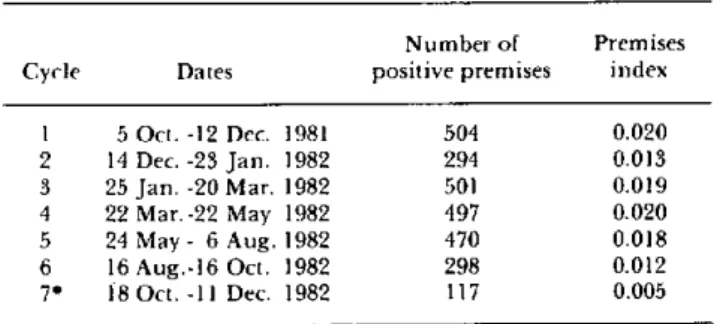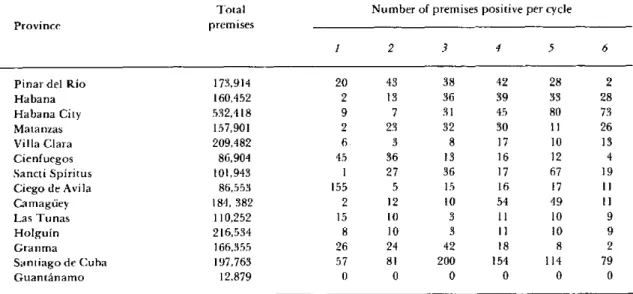pass all members of groups at increased risk for AIDS, even though it includes many individuals who may be at little risk of transmitting AIDS.
As long as the cause remains unknown, the ability to understand the natural history of AIDS and to under-take preventive measures is somewhat compromised. However, the above recommendations are prudent
measures that should reduce the risk of acquiring and transmitting AIDS.
(Source: Thomas C. Quinn, M.D., Senior Investigator, National Institutes of Allergy and Infectious Diseases, National Institutes of Health (USA), and MMWR32 (8): 102-103, March 1983.)
The Cuban Aedes aegypti
Campaign: a Year Later
The Epidemiological Bulletin Vol. 3, No. 1 (1982) reported on the program for dengue elimination and Aedes aegypti eradication following the 1981 epidemic of dengue when 344,203 cases and 158 deaths were reported in Cuba. Dengue was declared eliminated from Cuba on 16 November 1981 and, at that time, the premises index had been reduced from 35 and greater before the epidemic to 0.09.
On 5 October 1981 the consolidation phase of the eradication program began. The initial strategy was to do treatment cycles at two month intervals and verifica-tion cycles every one or two months depending on the area. During November 1982, a team from PAHO accompanied staff from the National Aedes aegypti Eradication Program to several areas in Cuba where statistical information of the first year of the consolida-tion phase was analyzed.
The technical information obtained from the inten-sive control measures that are being directed against A. aegypti in Cuba and the flexibility to combat techni-cal difficulties inherent in many programs have promp-ted a follow-up of the original report. The information presented may guide other member countries in seeking solutions for some of their control problems.
The program completed seven cycles on 11 December 1982. Table 1 gives the cycle schedule, number of posi-tive premises, and the premises index. As anticipated, the index did not vary greatly between cycles due to the fact that it is fairly easy to bring about a rapid reduction when the index is high but as the index of infestation approaches zero, the expenditure of effort greatly increases. Consequently, without increases in staff and supplies, any campaign may expect a static period before eradication is completed. Considering that the Cuban campaign is only 16 months old and covers approximately 2.5 million houses, the progress is remarkable.
Several factors account for the continued presence of positive premises despite the intensity of the campaign. By the third cycle, it was evident that the problem of control had shifted from an urban to a rural environ-ment (Table 2). At the same time it became necessary to place a greater priority on treatment of schools, facto-ries, and other nonresidential structures. Rural and industrial areas were identified as a cause for continued positivity at the beginning of the rainy season. Rains caused an increase of natural containers (tree holes, bamboo, coconut shells, etc.) serving as A. aegypti breeding sites and aggravated logistical problems because of dispersed premises in treatment and evalua-tion. Despite the logistical problem, the cycle schedule was maintained and in some risk areas, the number of evaluations actually increased.
Closed houses, a problem in many programs, has not caused concern in Cuba. The goal of 100 per cent cover-age was almost met in every cycle. For example, only 0.9 per cent of the houses were closed in the second cycle, 0.2 per cent in the third, 0.3 per cent in the fourth, and
Table 1. Premises found positive for Aedes aegypti
and premises index, by treatment cycle, Cuba, 1982.
Number of Premises Cycle Dates positive premises index
1 5 Oct. -12 Dec. 1981 504 0.020 2 14 Dec. -23 Jan. 1982 294 0.013 3 25 Jan. -20 Mar. 1982 501 0.019 4 22 Mar.-22 May 1982 497 0.020 5 24 May - 6 Aug. 1982 470 0.018 6 16 Aug.-16 Oct. 1982 298 0.012 7' 18Oct. -11 Dec. 1982 117 0.005
*Data incomplete.
8
.
.
Table 2. Urban/rural distribution of premises found positive for Aedes aegypti in cycles 3 and 4, Cuba, 1982.
Positive premises Cycle 3 Cycle 4
Total premises positive 501 497
Rural premises positive 344 299
Percentage of total positive
premises that are rural 68.7 60.2
Urban premises positive 93 90
Percentage of total positive
premises that are urban 18.6 18.1
Nonresidential premises positive' 64 108 Percentage of total positive
premises that are nonresidential 12.7 21.7
*Factories, schools, etc.
0.4 per cent in the fifth. This success was achieved by having staff follow a work schedule that fits the sea-sonal activity (in agriculture) and employment sche-dule (in industry) of the resident population. In addi-tion, staff rotated shifts to be available for follow-up work on Saturdays.
Because of the potential threat of insecticide resist-ance to organophosphate compounds (temephos was used as a larvicide and malathion as an adulticide), the campaign kept records of the principal breeding sites (Table 3). Less than 50 per cent of the containers were associated with potable water. Many of these could be closed in such a way that mosquitoes could not enter. The other potable water containers were treated with temephos and the remaining containers were elimi-nated. For example, 1,257,792 containers were treated with insecticide during cycle 5, while 2,215,825 con-tainers were destroyed. For cycle 6 a total of 1,979,259 containers were treated and 4,670,786 were destroyed. Some programs have questioned the economic effi-ciency of destroying breeding sites as a method of source reduction. However, the average number of premises treated per individual (18.9 from cycles 2 to 5) is compet-itive with programs in other countries and the conser-vation of insecticide is considerable. Because the evalu-ators are responsible only for premises inspection and health education, their output per day is greater.
Tires were identified as an important A. aegypti breeding site. One industrial area in Habana was rec-ognized as a principal source for tires throughout the country. To minimize the influence of transporting A. aegypti eggs from the area, a special team was sta-tioned there. One of its duties was to treat all tires with a residual insecticide.
The number of premises positive and the premises index per cycle is only a partial indication of the control
Table 3. Distribution of breeding sites, by container, cycles 1-4, Cuba, 1982.
Type of container Number positive Percentage
Low level water tanks 743 30
Tires 488 20
55 gallon metal tanks 300 12
Tin cans 181 7
Animal watering tanks 73 3
Wide mouth earthen jars 44 2
Elevated tanks 22 1
Cisterns and walls 26 1
Flower vases 18 1
Miscellaneous 576 23
picture. During cycles 5 through 7, the number of positive containers varied from 869 to 556 to 143 per cycle, and 1.85, 1.86, and 1.22positivecontainers,
respec-tively, per positive house. It is believed that this is an indication that the time interval between cycles is suffi-ciently short to curtail the spread of infestation.
Each positive premises is thoroughly studied to locate the primary breeding site. The history of the positive container is taken and if it originated from a site other than its present location, the earlier location is also inspected. Staff members of the Central Office visit more than 60 per cent of the premises found posi-tive per cycle. They have noted that only rarely is the same container or premises positive for two consecutive cycles. For the most part, new breeding sources origi-nate with the transportation of containers from shel-tered areas to places where they are exposed to water where dormant fertile eggs hatch. This phenomenon of chance exposure of fertile eggs to water is another
rea-son the final stages of eradication are a drawn out process.
The campaign continues to effect intensive control within a radius of 200 to 500 meters to each positive premises. Larviciding, adulticiding, and source reduc-tion are used along with increased inspecreduc-tion for missed containers. Septic tanks, hidden cisterns, depressions beneath warehouses, road ditches, and natural contain-ers have been identified as the missing primary breed-ing sites. When there is a problem of identification of a primary site, the number of ovitraps within the area is increased and space spraying is done daily for at least 10 days after all indication of adults or positive ovitraps stops.
Table 4 provides the status of the campaign within each province by cycle. Isla de la Juventud became negative during the intensive attack phase and has remained so for a year. The Province of Guantánamo became negative at cycle 6. A total of 16 municipalities in various provinces have been negative for a year and
Table 4. Status of eradication by cycle and province, Cuba, 1982.
Total Number of premises positive per cycle
Province premises
1 2 3 4 5 6
Pinar del Río 173,914 20 43 38 42 28 2
Habana 160,452 2 13 36 39 33 28
Habana City 532,418 9 7 31 45 80 73
Matanzas 157,901 2 23 32 30 11 26
Villa Clara 209,482 6 3 8 17 10 13
Cienfuegos 86,904 45 36 13 16 12 4
Sancti Spíritus 101,943 1 27 36 17 67 19
Ciego de Avila 86,553 155 5 15 16 17 11
Camaguey 184, 382 2 12 10 54 49 11
Las Tunas 110,252 15 10 3 11 10 9
Holguín 216,534 8 10 3 11 10 9
Granma 166,355 26 24 42 18 8 2
Santiago de Cuba 197,763 57 81 200 154 114 79
Guantánamo 12,879 0 0 0 0 0 0
*Cycles 4, 5, and 6 were during rainy season.
four more were negative during the last five cycles (10 months). Whenever a municipality becomes negative a
1 km barrier is designated around it. In this area addi-tional ovitraps are set out and more intensive inspec-tions are made. In addition, previously identified risk areas within the municipality received more ovitraps and inspections.
Beginning in January 1982, 6,000 larvitraps or ovi-traps were placed throughout the country. This number has been increased to 11,500. These are placed in air and sea port areas, cemeteries, known risk areas, and homes of staff members. Positivity is about 0.1 per cent.
Control activities are managed at the municipal and provincial level with a large component of community involvement. However, this horizontal-type program utilizes a technically strong central core to provideeval-uation and technical guidance. The central core has a chief, assistant chief, epidemiologist, entomologist,
two statisticians, and two technical officers which aver-age about 60 to 80 per cent of the time in the field. Weekly statistical reports are received by telephone and cable from all provinces. A special report is made on
each positive premises. By doing this, all information received is current. Extensive use of maps and statistical analysis makes it possible to study progress and adapt new strategies when required. An example of this is the fact that tropical storm David, which caused considera-ble damage in the area of Habana, did not produce a threat to the campaign due to this flexibility and ability to mobilize intensive control activities immediately.
As was mentioned in the 1982 report, an important factor in the campaign is the "esprit de corps" of the entire country toward the goal of A. aegypti eradica-tion. The impact an informed and cooperative com-munity has on a solution to the problem cannot be overestimated.
(Source: Tropical Diseases Program, Health Programs Development, PAHO, with assistance from staff of the Aedes aegypti Campaign, Ministry of Public Health, Cuba.)
.
10


